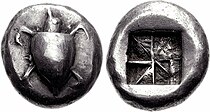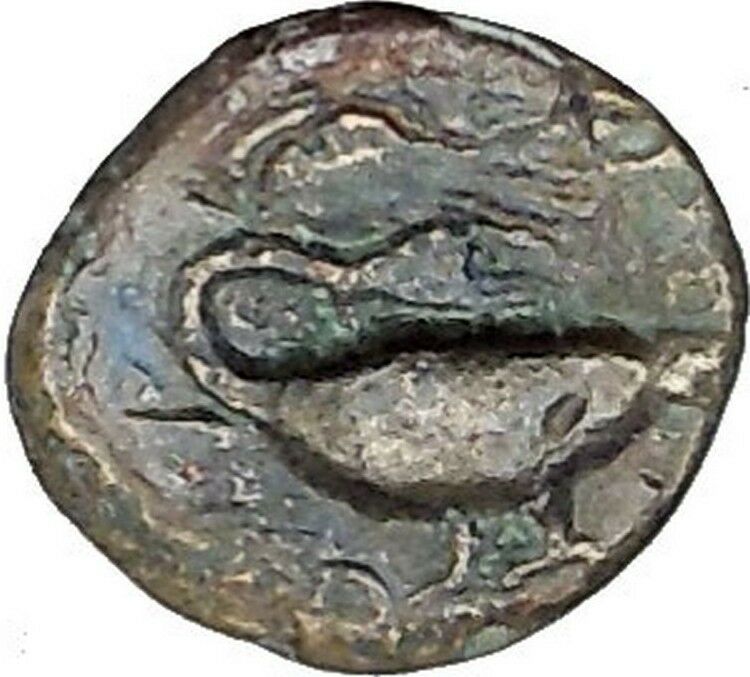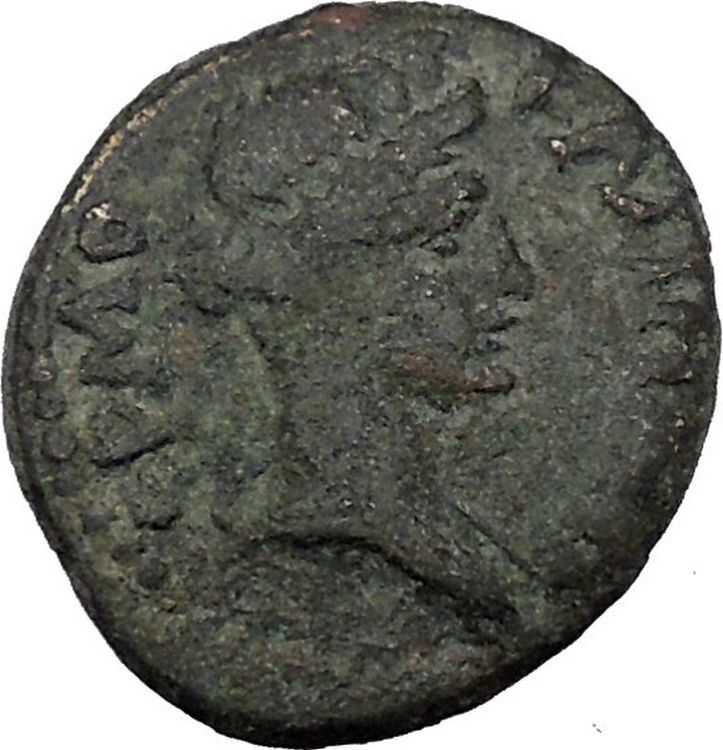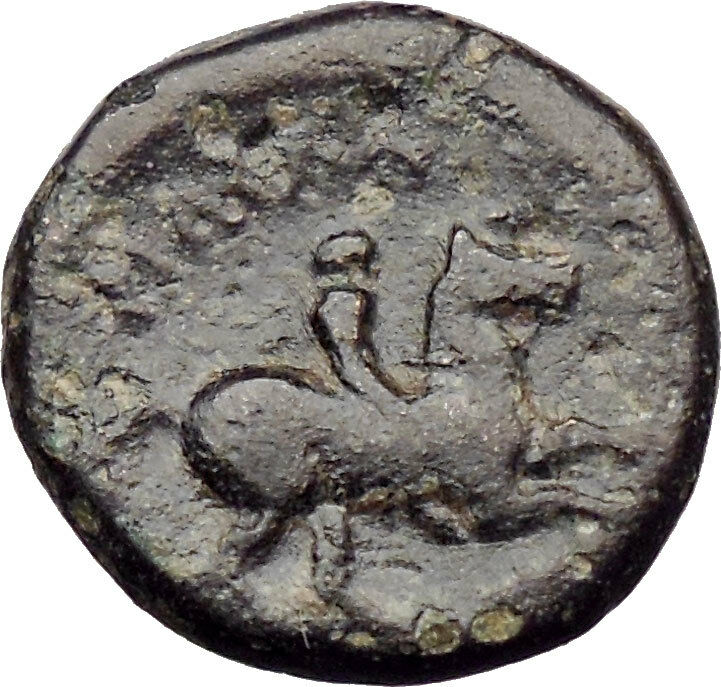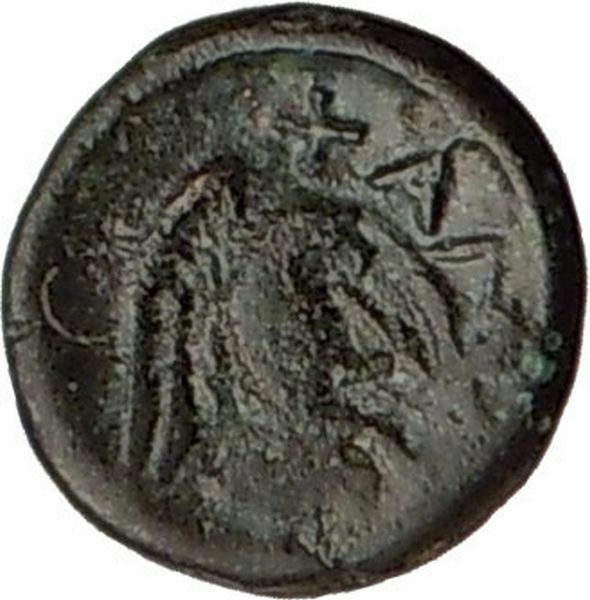|
Greek City of Selge in Psidia
Bronze 14mm (2.24 grams) Struck circa 150-50 B.C.
Reference: Sear 5489; B.M.C. 19.261,38-9
Head of bearded Hercules three-quarter face to right, wreathed with styrax; club
in in field to left.
Forepart of stag right, looking back; ΣE-Λ in
field.
The principal city of Pisidia, Selge was situated on the
Eurymedon river about 25 miles north of Aspendos. Its wealth derived from the
fertility of the surrounding country, and its inhabitants who claimed descent
from the Lakedaimonians, were the most warlike in Pisidia.
You are bidding on the exact item pictured,
provided with a Certificate of Authenticity and Lifetime Guarantee of
Authenticity.
HERCULES – This celebrated
of mythological romance was at first called Alcides, but received the name of
Hercules, or Heracles, from the Pythia of Delphos. Feigned by the poets of
antiquity to have been a son of “the Thunderer,” but born of an earthly mother,
he was exposed, through Juno’s implacable hatred to him as the offspring of
Alemena, to a course of perils, which commenced whilst he was yet in his cradle,
and under each of which he seemed to perish, but as constantly proved
victorious.
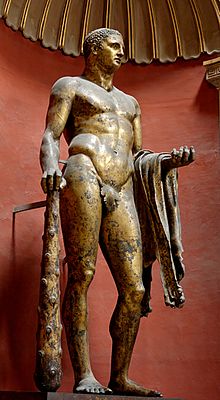
At
length finishing his allotted career with native valor and generosity, though
too frequently the submissive agent of the meanness and injustice of others, he
perished self-devotedly on the funeral pile, which was lighted on Mount Oeta.
Jupiter raised his heroic progeny to the skies; and Hercules was honored by the
pagan world, as the most illustrious of deified mortals. The extraordinary
enterprises cruelly imposed upon, but gloriously achieved, by this famous
demigod, are to be found depicted, not only on Greek coins, but also on the
Roman series both consular and imperial. The first, and one of the most
dangerous, of undertakings, well-known under the name of the twelve labors of
Hercules, was that of killing the huge lion of Nemea; on which account the
intrepid warrior is represented, clothes in the skin of that forest monarch; he
also bears uniformly a massive club, sometimes without any other arms, but at
others with a bow and quiver of arrows. On a denarius of the Antia gens he is
represented walking with trophy and club.
When his head alone is typified, as in Mucia gens, it is covered with the lion’s
spoils, in which distinctive decoration he was imitated by many princes, and
especially by those who claimed descent from him – as for example, the kings of
Macedonia, and the successors of Alexander the Great. Among the Roman emperors
Trajan is the first whose coins exhibit the figure and attributes of Hercules.
Selge (in
Greek/font>
Σελγη) was an important city in
Pisidia
, on
the southern slope of
Mount Taurus
, at the part where the river
Eurymedon River
forces its way through the mountains towards the south.
The town was believed to be a
Greek colony
, for
Strabo
states that it was founded by
Spartans
, but
adds the somewhat unintelligible remark that previously it had been founded by
Calchas
. The
acropolis
of Selge bore the name of Kesbedion.
The district in which the town was situated was extremely fertile, producing
abundance of oil and wine, but the town itself was difficult of access, being
surrounded by precipices and beds of torrents flowing towards the Eurymedon and
Cestrus (today Aksu)
, and requiring bridges to make them passable. In
consequence of its excellent laws and political constitution, Selge rose to the
rank of the most powerful and populous city of Pisidia, and at one time was able
to send an army of 20,000 men into the field. Owing to these circumstances, and
the valour of its inhabitants, for which they were regarded as worthy kinsmen of
the Spartans, the Selgians were never subject to any foreign power, but remained
in the enjoyment of their own freedom and independence. When
Alexander the Great
passed through Pisidia (333 BC), Selge sent an embassy
to him and gained his favour and friendship.
At that time they were at war with
Termessos
.
At the period when
Achaeus
had made himself master of Western Asia, Selge were at war with
Pednelissus
, which was besieged by them; and Achaeus, on the invitation of
Pednelissus, sent a large force against Selge (218 BC). After a long and
vigorous siege, the Selgians, being betrayed and despairing of resisting Achaeus
any longer, sent deputies to sue for peace, which was granted to them on the
following terms: they agreed to pay immediately 400
talents
, to restore the prisoners of Pednelissus, and after a time to pay
300 talents in addition.
We now have for a long time no particulars about the history of Selge; in the
5th century AD Zosimus
calls it indeed a little town, but it was still strong enough to repel a body of
Goths
. It is
strange that
Pliny
does not notice Selge, for we know from its coins that it was still a
flourishing town in the time of
Hadrian
; and
it is also mentioned in
Ptolemy
and
Hierocles
. Independently of wine and oil, the country about Selge was rich
in timber, and a variety of trees, among which the
storax
was much
valued from its yielding a strong perfume. Selge was also celebrated for an
ointment prepared from the iris root.
The remains of the city consist mainly of parts of the encircling wall and of
the acropolis. A few traces have survived of the
gymnasium
, the stoa
,
the stadium
and the basilica
. There are also the outlines of two temples, but the best conserved
monument is the
theater
, restored in the 3rd century AD.
Halfway on the road to Selge from the
Pamphylian
coastal plain,
a well-preserved Roman Bridge
crosses the deep
Eurymedon
valley.
The history of
Ancient Greek
coinage can be divided (along
with most other Greek art forms) into four periods, the
Archaic
, the
Classical
, the
Hellenistic
and the
Roman
. The Archaic period extends from the
introduction of coinage to the Greek world during the
7th century BC
until the
Persian Wars
in about 480 BC. The Classical
period then began, and lasted until the conquests of
Alexander the Great
in about 330 BC, which
began the Hellenistic period, extending until the
Roman
absorption of the Greek world in the 1st
century BC. The Greek cities continued to produce their own coins for several
more centuries under Roman rule. The coins produced during this period are
called
Roman provincial coins
or Greek Imperial Coins.
Ancient Greek coins of all four periods span over a period of more than ten
centuries.
Weight
standards and denominations

Above: Six rod-shaped obeloi (oboloi) displayed at the
Numismatic Museum of Athens
,
discovered at
Heraion of Argos
. Below: grasp[1]
of six oboloi forming one drachma

Electrum
coin from
Ephesus
, 620-600 BC, known as
Phanes’ coin
. Obverse:
Stag
grazing, ΦΑΝΕΩΣ (retrograde).
Reverse: Two incuse punches.
The basic standards of the Ancient Greek monetary system were the
Attic
standard, based on the Athenian
drachma
of 4.3 grams of silver and the
Corinthian
standard based on the
stater
of 8.6 grams of silver, that was
subdivided into three silver drachmas of 2.9 grams. The word
drachm
(a) means “a handful”, literally “a
grasp”. Drachmae were divided into six
obols
(from the Greek word for a
spit
), and six spits made a “handful”. This
suggests that before coinage came to be used in Greece, spits in
prehistoric times
were used as measures of
daily transaction. In archaic/pre-numismatic times iron was valued for making
durable tools and weapons, and its casting in spit form may have actually
represented a form of transportable
bullion
, which eventually became bulky and
inconvenient after the adoption of precious metals. Because of this very aspect,
Spartan
legislation famously forbade issuance
of Spartan coin, and enforced the continued use of iron spits so as to
discourage avarice and the hoarding of wealth. In addition to its original
meaning (which also gave the
euphemistic
diminutive
“obelisk“,
“little spit”), the word obol (ὀβολός, obolós, or ὀβελός,
obelós) was retained as a Greek word for coins of small value, still used as
such in Modern Greek
slang (όβολα, óvola,
“monies”).
The obol was further subdivided into tetartemorioi (singular
tetartemorion) which represented 1/4 of an obol, or 1/24 of a drachm. This
coin (which was known to have been struck in
Athens
,
Colophon
, and several other cities) is
mentioned by Aristotle
as the smallest silver coin.:237
Various multiples of this denomination were also struck, including the
trihemitetartemorion (literally three half-tetartemorioi) valued at 3/8 of
an obol.:
| Denominations of silver drachma |
| Image |
Denomination |
Value |
Weight |
|
|
Dekadrachm |
10 drachmas |
43 grams |
|
|
Tetradrachm |
4 drachmas |
17.2 grams |
|
|
Didrachm |
2 drachmas |
8.6 grams |
|
|
Drachma |
6 obols |
4.3 grams |
|
|
Tetrobol |
4 obols |
2.85 grams |
|
|
Triobol (hemidrachm) |
3 obols |
2.15 grams |
|
|
Diobol |
2 obols |
1.43 grams |
|
|
Obol |
4 tetartemorions |
0.72 grams |
|
|
Tritartemorion |
3 tetartemorions |
0.54 grams |
|
|
Hemiobol |
2 tetartemorions |
0.36 grams |
|
|
Trihemitartemorion |
3/2 tetartemorions |
0.27 grams |
|
|
Tetartemorion |
|
0.18 grams |
|
|
Hemitartemorion |
½ tetartemorion |
0.09 grams |
Archaic period
Archaic coinage
Uninscribed
electrum
coin from
Lydia
, 6th century BCE.
Obverse: lion head and sunburst Reverse: plain square
imprints, probably used to standardise weight
Electrum
coin from
Ephesus
, 620-600 BC. Obverse:
Forepart of stag. Reverse: Square incuse punch.
The first coins were issued in either Lydia or Ionia in Asia Minor at some
time before 600 BC, either by the non-Greek Lydians for their own use or perhaps
because Greek mercenaries wanted to be paid in precious metal at the conclusion
of their time of service, and wanted to have their payments marked in a way that
would authenticate them. These coins were made of
electrum
, an alloy of gold and silver that was
highly prized and abundant in that area. By the middle of the 6th century BC,
technology had advanced, making the production of pure gold and silver coins
simpler. Accordingly, King
Croesus
introduced a bi-metallic standard that
allowed for coins of pure gold and pure silver to be struck and traded in the
marketplace.
Coins of Aegina
Silver
stater
of Aegina, 550-530 BC.
Obv.
Sea turtle
with large pellets
down center. Rev. incuse square with eight sections. After the
end of the
Peloponnesian War
, 404 BC, Sea
turtle was replaced by the land
tortoise
.
Silver
drachma
of Aegina, 404-340 BC.
Obverse: Land
tortoise
. Reverse: inscription
AΙΓ[INAΤΟΝ] ([of the] Aeg[inetans]) “Aegina” and dolphin.
The Greek world was divided into more than two thousand self-governing
city-states (in
Greek
, poleis), and more than half of
them issued their own coins. Some coins circulated widely beyond their polis,
indicating that they were being used in inter-city trade; the first example
appears to have been the silver stater or didrachm of
Aegina
that regularly turns up in hoards in
Egypt
and the
Levant
, places which were deficient in silver
supply. As such coins circulated more widely, other cities began to mint coins
to this “Aeginetan” weight standard of (6.1 grams to the drachm), other cities
included their own symbols on the coins. This is not unlike present day
Euro coins, which are recognisably from a particular country, but
usable all over the
Euro zone
.
Athenian coins, however, were struck on the “Attic” standard, with a drachm
equaling 4.3 grams of silver. Over time, Athens’ plentiful supply of silver from
the mines at
Laurion
and its increasing dominance in trade
made this the pre-eminent standard. These coins, known as “owls” because of
their central design feature, were also minted to an extremely tight standard of
purity and weight. This contributed to their success as the premier trade coin
of their era. Tetradrachms on this weight standard continued to be a widely used
coin (often the most widely used) through the classical period. By the time of
Alexander the Great
and his
Hellenistic successors
, this large denomination
was being regularly used to make large payments, or was often saved for
hoarding.
Classical period
A
Syracusan
tetradrachm
(c. 415–405
BC)
Obverse: head of the
nymph
Arethusa
, surrounded by
four swimming
dolphins
and a
rudder
Reverse: a racing
quadriga
, its
charioteer
crowned by the
goddess
Victory
in flight.
Tetradrachm of Athens, (5th century BC)
Obverse: a portrait of
Athena
, patron goddess of
the city, in
helmet
Reverse: the owl of Athens, with an
olive
sprig and the
inscription “ΑΘΕ”, short for ΑΘΕΝΑΙΟΝ, “of the
Athenians
“
The
Classical period
saw Greek coinage reach a high
level of technical and aesthetic quality. Larger cities now produced a range of
fine silver and gold coins, most bearing a portrait of their patron god or
goddess or a legendary hero on one side, and a symbol of the city on the other.
Some coins employed a visual pun: some coins from
Rhodes
featured a
rose, since the Greek word for rose is rhodon. The use of
inscriptions on coins also began, usually the name of the issuing city.
The wealthy cities of Sicily produced some especially fine coins. The large
silver decadrachm (10-drachm) coin from
Syracuse
is regarded by many collectors as the
finest coin produced in the ancient world, perhaps ever. Syracusan issues were
rather standard in their imprints, one side bearing the head of the nymph
Arethusa
and the other usually a victorious
quadriga
. The
tyrants of Syracuse
were fabulously rich, and
part of their
public relations
policy was to fund
quadrigas
for the
Olympic chariot race
, a very expensive
undertaking. As they were often able to finance more than one quadriga at a
time, they were frequent victors in this highly prestigious event.
Syracuse was one of the epicenters of numismatic art during the classical
period. Led by the engravers Kimon and Euainetos, Syracuse produced some of the
finest coin designs of antiquity.
Hellenistic period

Gold 20-stater
of
Eucratides I
, the largest gold coin
ever minted in Antiquity.

Drachma of
Alexandria
, 222-235 AD. Obverse:
Laureate head of
Alexander Severus
, KAI(ΣΑΡ)
MAP(ΚΟΣ) AYP(ΗΛΙΟΣ) ΣЄY(ΑΣΤΟΣ) AΛЄΞANΔPOΣ ЄYΣЄ(ΒΗΣ). Reverse: Bust
of
Asclepius
.
The Hellenistic period was characterized by the spread of Greek
culture across a large part of the known world. Greek-speaking kingdoms were
established in Egypt
and
Syria
, and for a time also in
Iran and as far east as what is now
Afghanistan
and northwestern
India
. Greek traders spread Greek coins across
this vast area, and the new kingdoms soon began to produce their own coins.
Because these kingdoms were much larger and wealthier than the Greek city states
of the classical period, their coins tended to be more mass-produced, as well as
larger, and more frequently in gold. They often lacked the aesthetic delicacy of
coins of the earlier period.
Still, some of the
Greco-Bactrian
coins, and those of their
successors in India, the
Indo-Greeks
, are considered the finest examples
of
Greek numismatic art
with “a nice blend of
realism and idealization”, including the largest coins to be minted in the
Hellenistic world: the largest gold coin was minted by
Eucratides
(reigned 171–145 BC), the largest
silver coin by the Indo-Greek king
Amyntas Nikator
(reigned c. 95–90 BC). The
portraits “show a degree of individuality never matched by the often bland
depictions of their royal contemporaries further West” (Roger Ling, “Greece and
the Hellenistic World”).
The most striking new feature of Hellenistic coins was the use of portraits
of living people, namely of the kings themselves. This practice had begun in
Sicily, but was disapproved of by other Greeks as showing
hubris
(arrogance). But the kings of
Ptolemaic Egypt
and
Seleucid Syria
had no such scruples: having
already awarded themselves with “divine” status, they issued magnificent gold
coins adorned with their own portraits, with the symbols of their state on the
reverse. The names of the kings were frequently inscribed on the coin as well.
This established a pattern for coins which has persisted ever since: a portrait
of the king, usually in profile and striking a heroic pose, on the obverse, with
his name beside him, and a coat of arms or other symbol of state on the reverse.
Minting
All Greek coins were
handmade
, rather than machined as modern coins
are. The design for the obverse was carved (in
incuso
) into a block of bronze or possibly
iron, called a
die
. The design of the reverse was carved into
a similar punch. A blank disk of gold, silver, or electrum was cast in a mold
and then, placed between these two and the punch struck hard with a hammer,
raising the design on both sides of the coin.
Coins as
a symbol of the city-state
Coins of Greek city-states depicted a unique
symbol
or feature, an early form of
emblem
, also known as
badge
in numismatics, that represented their
city and promoted the prestige of their state. Corinthian stater for example
depicted pegasus
the mythological winged stallion, tamed
by their hero
Bellerophon
. Coins of
Ephesus
depicted the
bee
sacred to
Artemis
. Drachmas of Athens depicted the
owl of Athena
. Drachmas of
Aegina
depicted a
chelone
. Coins of
Selinunte
depicted a “selinon” (σέλινον
– celery
). Coins of
Heraclea
depicted
Heracles
. Coins of
Gela depicted a man-headed bull, the personification of the river
Gela
. Coins of
Rhodes
depicted a “rhodon” (ῥόδον[8]
– rose
). Coins of
Knossos
depicted the
labyrinth
or the mythical creature
minotaur
, a symbol of the
Minoan Crete
. Coins of
Melos
depicted a “mēlon” (μήλον –
apple
). Coins of
Thebes
depicted a Boeotian shield.
Corinthian stater with
pegasus
Coin of
Rhodes
with a
rose
Didrachm of
Selinunte
with a
celery
Coin of
Ephesus
with a
bee
Stater of
Olympia
depicting
Nike
Coin of
Melos
with an
apple
Obolus from
Stymphalia
with a
Stymphalian bird
Coin of
Thebes
with a Boeotian shield
Coin of Gela
with a man-headed bull,
the personification of the river
Gela
Didrachm of
Knossos
depicting the
Minotaur
Commemorative coins

Dekadrachm
of
Syracuse
[disambiguation
needed]. Head of Arethusa or queen
Demarete. ΣΥΡΑΚΟΣΙΟΝ (of the Syracusians), around four dolphins
The use of
commemorative coins
to celebrate a victory or
an achievement of the state was a Greek invention. Coins are valuable, durable
and pass through many hands. In an age without newspapers or other mass media,
they were an ideal way of disseminating a political message. The first such coin
was a commemorative decadrachm issued by
Athens
following the Greek victory in the
Persian Wars
. On these coins that were struck
around 480 BC, the owl
of Athens, the goddess
Athena
‘s sacred bird, was depicted facing the
viewer with wings outstretched, holding a spray of olive leaves, the
olive tree
being Athena’s sacred plant and also
a symbol of peace and prosperity. The message was that Athens was powerful and
victorious, but also peace-loving. Another commemorative coin, a silver
dekadrachm known as ” Demareteion”, was minted at
Syracuse
at approximately the same time to
celebrate the defeat of the
Carthaginians
. On the obverse it bears a
portrait of
Arethusa
or queen Demarete.
Ancient Greek coins
today
Collections of Ancient Greek coins are held by museums around the world, of
which the collections of the
British Museum
, the
American Numismatic Society
, and the
Danish National Museum
are considered to be the
finest. The American Numismatic Society collection comprises some 100,000
ancient Greek coins from many regions and mints, from Spain and North Africa to
Afghanistan. To varying degrees, these coins are available for study by
academics and researchers.
There is also an active collector market for Greek coins. Several auction
houses in Europe and the United States specialize in ancient coins (including
Greek) and there is also a large on-line market for such coins.
Hoards of Greek coins are still being found in Europe, Middle East, and North
Africa, and some of the coins in these hoards find their way onto the market.
Coins are the only art form from the Ancient world which is common enough and
durable enough to be within the reach of ordinary collectors.
|


